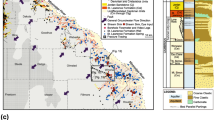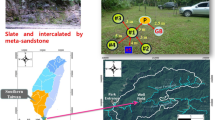Abstract
A detailed and integrated geologic–hydraulic–geophysical–geochemical study of groundwater flow in the near-vicinity of a borehole drilled into fractured and karstified limestone demonstrates the power of such an integrated approach in localising and characterising preferential groundwater flow pathways and ambient borehole flow. The study, conducted in the vicinity of a 100-m-deep research borehole on the island of Mallorca, achieves such characterisation on a scale from millimetres to tens of metres in scale. More specifically, it adds single packer and open-hole pumping test interpretations to the results obtained during fluid logging, impeller flowmeter testing, borehole imaging, core descriptions and an innovative fracture analysis. This approach allows the delineation of the main flowing features and showed that such features are directly or indirectly linked to karst phenomena. Understanding this complex flow system is critical for an appropriate assessment of groundwater resources and the design of sustainable groundwater production schemes.
Résumé
La conduite d’une étude détaillée et exhaustive comprenant des volets géologiques, hydrauliques, géophysiques et géochimiques et portant sur les écoulements souterrains à proximité d’un forage dans un calcaire fracturé et karstifié démontre les potentialités d’une telle approche, dans les buts de localiser et caractériser les directions préférentielles des écoulements souterrains et les flux dans l’ouvrage au repos. La présente étude, menée à proximité d’un forage expérimental de 100 m sur l’île de Majorque, accomplit cette caractérisation à des échelles millimétriques à décamétriques. Les interprétations de pompages d’essai en trou ouvert et avec obturateur simple complètent en effet les résultats issus des diagraphies de production, des diagraphies de flux, de l’imagerie de paroi, des études de carottes et d’une analyse novatrice des fractures. Cette approche permet de dégager les caractéristiques des venues d’eau majeures et a montré que ces dernières sont directement ou indirectement liées aux phénomènes karstiques. La compréhension de ce système d’écoulement complexe est primordiale pour estimer adéquatement les ressources en eaux souterraines, et pour élaborer des plans durables d’exploitation de ces eaux souterraines.
Resumen
Un estudio geológico-hidráulico-geofìsico-geoquímico de agua subterránea detallado e integrado del flujo de agua subterránea a los alrededores de un pozo perforado en caliza kárstica y fracturada muestra el poder de tal enfoque integrado para la localización y caracterización de rutas preferenciales de flujo de agua subterránea y flujo ambiental del pozo. El estudio, llevado a cabo en la proximidad de un pozo de investigación de 100 metros de profundidad en la isla de Mallorca, logra esta caracterización en una escala de milímetros a decenas de metros. Más específicamente el estudio añade interpretaciones de datos de preubas de packer sencillo y de bombeo de pozo abierto obtenidos durante mapeo fluido, medidas de flujo métrico con impeller, imágenes del pozo, descripciones del núcleos de barrenación y un análisis de fracturas innovador. Este enfoque permite la delineación de los rasgos principales del flujo y mostró que tales rasgos están directamente o indirectamente relacionados a fenómenos de karst. Entender el sistema de flujo complejo es crítico para una evaluación apropiada de los recursos de agua subterránea y para el diseño de esquemas de producción de agua subterránea sostenibles.

















Similar content being viewed by others
References
Aeschbach-Hertig W et al (1998) A 3H/3He study of ground water flow in a fractured bedrock aquifer. Ground Water 36(4):661
Arfib B, de MG, Ganoulis J (2000) Pollution by seawater intrusion into a karst system: new research in the case of the Almyros Source (Heraklio, Crete, Greece). In: S Lojen, H Doctor Daniel, AR Byrne (eds) Papers presented at the International workshop “Groundwater pollution in karst: preserving water quality in karst systems”. Slovenska Akademija Znanosti in Umetnosti, Ljubljana, Slovenia
Barón Périz A, González Casasnovas C (1987) Hidrogeología de la isla de Mallorca, IV [Hydrogeology of Mallorca]. Simposio de Hidrogeología. Servicio Hidráulico de Baleares, Palma de Mallorca, 82 pp
Cardoso da Silva Junior G (1997) Comportamiento de los manatiales dels karst nororiental de la Serra de Tramuntana, Mallorca [Behaviour of the northeastern karst springs of the Serra de Tramuntana, Mallorca]. PhD Thesis, Universitat Poltècnica de Catalunya, Barcelona
Custodio E, Bayó A, Pascual M, Bosch X (1991) Results from studies in several karst formations in southern Catalonia (Spain). In: G Gunay, AI Johnson, W Back (eds) Hydrogeological processes in karst terranes. IAHS-AISH Publication. International Association of Hydrological Sciences, Louvain, pp 295–326
Gelabert B (1997) La estructura geológico de la mitad occidental de la isla de Mallorca [Geological structure of the western half of Mallorca]. Memoria del Instituto Tecnologico Geominero de España Thesis, Universidad Politécnica de Cataluña, Barcelona, p 129
Gelabert B et al (1996) Nuevas perspectivas sobre la unidad hidrogeológico de S’Almadrava, Serra de Tramuntana (Mallorca): interpretación de datos químicos e isotópicos basada en estodios geológicos [New insights into the hydrogeological unit of S’Almadrava, Serra de Tramuntana (Mallorca)]. Conference Proceedings Recursos Hidricos en Regiones Karsticos, Conference Proceedings, Vitoria-Gasteiz, Spain, pp 201–216
González Casasnovas C, López García JM, Mateos Ruíz RM (2000) El estado de las aguas subterráneas en el archipiélago Balear: Isla de Mallorca [The current state of groundwater in Balearic islands: the island of Mallorca]. Govern de les Illes Baleares. Conselleria de Medi Ambient-Eptisa, Palma de Mallorca
Hale FV, Tsang CF (1988) A code to compute borehole fluid conductivity profiles with multiple feed points. NAGRA, pp 88–21
Hearst JR, Nelson PH, Paillet FL (2000) Well logging for physical properties: a handbook for geophysicists, geologists and engineers. Wiley, Chichester, p 483
Hoehn E et al (1998) The Grimsel migration experiment: field injection-withdrawal experiments in fractured rock with sorbing tracers. J Contam Hydrol 34(1–2):85
Karasaki K (1990) A systematized drillstem test. Water Resour Res 26(12):2913
López García JM (1999) Cartografía geológica a escala 1:25.000 del sector Pollensa-Bahía de Pollensa (Mallorca) [Geological map at a scale of 1:25000 for the part of Pollensa-Pollensa Bay (Mallorca)], Palma de Mallorca
Milnes E, Renard P (2004) The problem of salt recycling and seawater intrusion in coastal irrigated plains: an example from the Kiti aquifer (southern Cyprus). J Hydrol 288(1–4):327–343
Paillet FL (1993) Using borehole geophysics and cross-borehole flow testing to define hydraulic connections between fracture zones in bedrock aquifers. J Appl Geophys 30(4):261
Paillet FL (1995) Using Borehole flow logging to optimise hydraulic test procedures in heterogeneous fractured aquifers. Hydrogeol J 3(3):4–20
Parra JO, Hackert CL, Xu PC (2002) Characterization of fractured low Q zones at the Buena Vista Hills reservoir, California. Geophysics 67(4):1061
Petalas CP, Diamantis IB (1999) Origin and distribution of saline groundwaters in the upper Miocene aquifer system, coastal Rhodope area, northeastern Greece. Hydrogeol J 7(3):305–316
Sanz E et al (2002) Modelling coastal salty springs: first approach in carbonate media (S’Almadrava, Mayorca, Spain). In: Boekelman RH et al (eds) 17th Salt Water Intrusion Meeting (SWIM17). Delft University of Technology, Delft, The Netherlands, pp 195–203
Schnegg PA, Doerfliger N (1997) An inexpensive flow-through field fluorometer. 6th Conference on Limestone Hydrology and Fissured Media, Conference proceedings, La Chaux-de-Fonds, Switzerland, pp 47–50
Skinner D, Heinson G (2004) A comparison of electrical and electromagnetic methods for the detection of hydraulic pathways in a fractured rock aquifer, Clare Valley, South Australia. Hydrogeol J 12(5):576–590
Tsang C-F, Hufschmied P (1988) A borehole fluid conductivity logging method for the determination of fracture inflow parameters. Nagra, Baden, Switzerland, pp 88–13
Tsang CF, Hufschmied P, Hale FV (1990) Determination of fracture inflow parameters with a borehole fluid conductivity logging method. Water Resour Res 26(4):561–578
Tulipano L, Fidelibus MD (1996) Multitracing approach for the identification of main hydrogeological pathways feeding coastal springs of karstic aquifer. In: Buddemeier RW (ed) Groundwater discharge in the coastal zone: proceedings of an international symposium held at the Russian Academy of Sciences. LOICZ Reports and Studies. LOICZ Core Project, Netherlands Institute for Sea Research, Texel, Netherlands, pp 113–121
Zanini L et al (2000) Ground water flow in a fractured carbonate aquifer inferred from combined hydrogeological and geochemical measurements. Ground Water 38(3):350
Acknowledgements
The authors would like to thank the European Commission for funding the ALIANCE project (contract EKV1-2001-00039) of which this study forms part. They would also like to thank their colleagues of the CNRS and the University of Montpellier for their collaboration and their geophysical data, the borehole televiewer and acoustic televiewer, Philippe Gouze and Patrick Pinettes. The authors express their gratitude to C. González Casasnova and A. Barón Períz of the Balearic Water Authority for their co-operation and their financial support. We also acknowledge the constructive remarks and corrections of two anonymous reviewers.
Author information
Authors and Affiliations
Corresponding author
Rights and permissions
About this article
Cite this article
Van Meir, N., Jaeggi, D., Herfort, M. et al. Characterizing flow zones in a fractured and karstified limestone aquifer through integrated interpretation of geophysical and hydraulic data. Hydrogeol J 15, 225–240 (2007). https://doi.org/10.1007/s10040-006-0086-4
Received:
Accepted:
Published:
Issue Date:
DOI: https://doi.org/10.1007/s10040-006-0086-4




